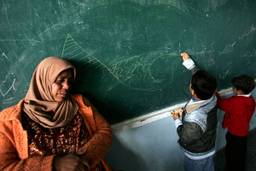Magdalena Emperatriz was kidnapped on May 31, 1982, during a counter-insurgency campaign carried out by the Salvadoran army. She was 15 days old. The campaign resulted in the killing of hundreds of civilians and the destruction of dozens of towns and hamlets as well as the abduction and disappearance of 54 small children.
In 1995, when Magdalena was 13 years old, she was located in an orphanage in San Salvador. The late Dr. Robert Kirschner, former director of the International Forensic Program of Physicians for Human Rights, identified the girl through an analysis of her and the presumed father’s DNA. The two were finally reunited.
Most of the missing people around the globe are not as lucky. In Guatemala, Haiti and Colombia, thousands of families have no knowledge of the fate of their missing relatives. The same is true in Congo, Burundi and Uganda. Indeed, hundreds of thousands of families from more than 60 countries around the world—including the United States, Canada and Mexico—wait day after day for some news about their missing loved ones. The “unaccounted for” can be conceived as a global epidemic.
The term “missing” refers to a wide range of situations resulting from armed conflict and internal violence: people missing in action or held in some form of incommunicado detention, internally displaced people, and the victims of enforced disappearances. Regardless of the specific circumstances, the victims’ families share a sense of uncertainty that leads to immense suffering.
In an attempt to heighten awareness about the missing, the International Committee of the Red Cross convened an international conference in February 2003. For the first time in history, government representatives, family groups, NGOs, military officers, scientists, and others gathered together to create tools that would ensure the authorities responsible for resolving the problem of missing people would be held accountable.
Different aspects of the phenomenon were addressed during the conference, ranging from improving scientific mechanisms of identification to preventing disappearances by establishing new regulations for military personnel. In addition, guidelines were formulated on how to support the victims’ families, emphasizing the important role states can play in providing families with financial, psychological and legal assistance. “The conference was an extraordinary milestone,” Leonard Rubenstein, executive director of Physicians for Human Rights, claimed, “not only because it succeeded in putting the issue of missing people on the map, but also because it allowed experts from all over the world to begin developing international standards for confronting the phenomenon.”
There was, however, one major drawback, which went unreported by media covering the conference. The conference’s motto was “The Right to Know.” This slogan was inscribed on small bags distributed to the participants and was used on the meeting’s banner. The idea behind it is straightforward: The relatives of the missing people have a right to know whether the victims are dead or alive, and their whereabouts.
One would have thought, along with the conference organizers and most of the participants, that the right to know is a basic entitlement, and, as such, unanimously accepted. The U.S. government delegation viewed things differently, however, demanding that the “right to know” be erased from the final statement.
To know, they argued, is not a right; it is not established in international law, and although there is reference to such a right in Protocol I (an addition to the Fourth Geneva Convention, which makes reference to the right of families to know the fate of their relatives), the United States has not signed the Protocol.
That was more or less their line of argument. The subtext was that reference to a right to know would begin a movement toward further recognition of this right. Such recognition, the officials seem to believe, is inimical to U.S. interests—particularly at times of war.
The members of the U.S. delegation won the day, while the hundreds of thousands of people whose relatives are still missing lost.
In 1995, when Magdalena was 13 years old, she was located in an orphanage in San Salvador. The late Dr. Robert Kirschner, former director of the International Forensic Program of Physicians for Human Rights, identified the girl through an analysis of her and the presumed father’s DNA. The two were finally reunited.
Most of the missing people around the globe are not as lucky. In Guatemala, Haiti and Colombia, thousands of families have no knowledge of the fate of their missing relatives. The same is true in Congo, Burundi and Uganda. Indeed, hundreds of thousands of families from more than 60 countries around the world—including the United States, Canada and Mexico—wait day after day for some news about their missing loved ones. The “unaccounted for” can be conceived as a global epidemic.
The term “missing” refers to a wide range of situations resulting from armed conflict and internal violence: people missing in action or held in some form of incommunicado detention, internally displaced people, and the victims of enforced disappearances. Regardless of the specific circumstances, the victims’ families share a sense of uncertainty that leads to immense suffering.
In an attempt to heighten awareness about the missing, the International Committee of the Red Cross convened an international conference in February 2003. For the first time in history, government representatives, family groups, NGOs, military officers, scientists, and others gathered together to create tools that would ensure the authorities responsible for resolving the problem of missing people would be held accountable.
Different aspects of the phenomenon were addressed during the conference, ranging from improving scientific mechanisms of identification to preventing disappearances by establishing new regulations for military personnel. In addition, guidelines were formulated on how to support the victims’ families, emphasizing the important role states can play in providing families with financial, psychological and legal assistance. “The conference was an extraordinary milestone,” Leonard Rubenstein, executive director of Physicians for Human Rights, claimed, “not only because it succeeded in putting the issue of missing people on the map, but also because it allowed experts from all over the world to begin developing international standards for confronting the phenomenon.”
There was, however, one major drawback, which went unreported by media covering the conference. The conference’s motto was “The Right to Know.” This slogan was inscribed on small bags distributed to the participants and was used on the meeting’s banner. The idea behind it is straightforward: The relatives of the missing people have a right to know whether the victims are dead or alive, and their whereabouts.
One would have thought, along with the conference organizers and most of the participants, that the right to know is a basic entitlement, and, as such, unanimously accepted. The U.S. government delegation viewed things differently, however, demanding that the “right to know” be erased from the final statement.
To know, they argued, is not a right; it is not established in international law, and although there is reference to such a right in Protocol I (an addition to the Fourth Geneva Convention, which makes reference to the right of families to know the fate of their relatives), the United States has not signed the Protocol.
That was more or less their line of argument. The subtext was that reference to a right to know would begin a movement toward further recognition of this right. Such recognition, the officials seem to believe, is inimical to U.S. interests—particularly at times of war.
The members of the U.S. delegation won the day, while the hundreds of thousands of people whose relatives are still missing lost.
Neve Gordon teaches in the Department of Politics and Government, Ben-Gurion University of the Negev, in Israel. One can read about his most recent book, Israel’s Occupation, and more at www.israelsoccupation.info.







